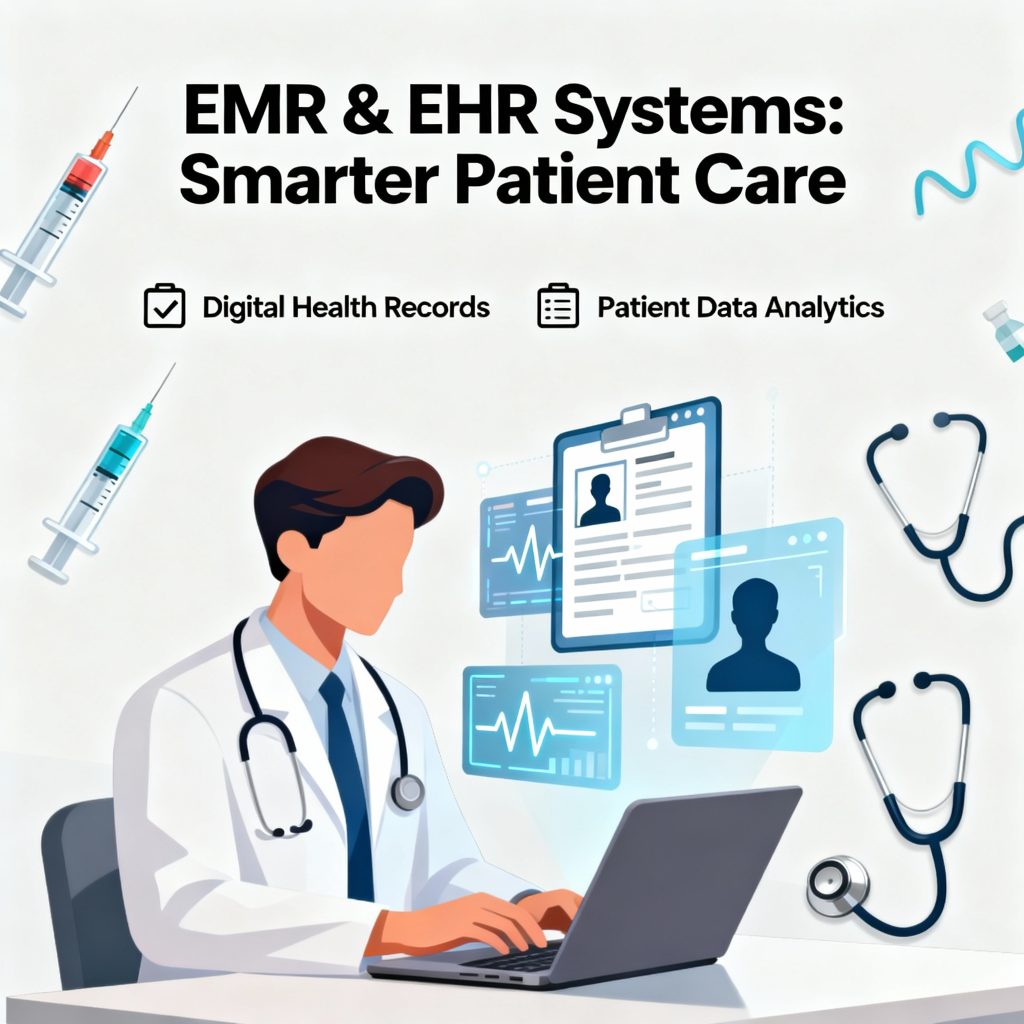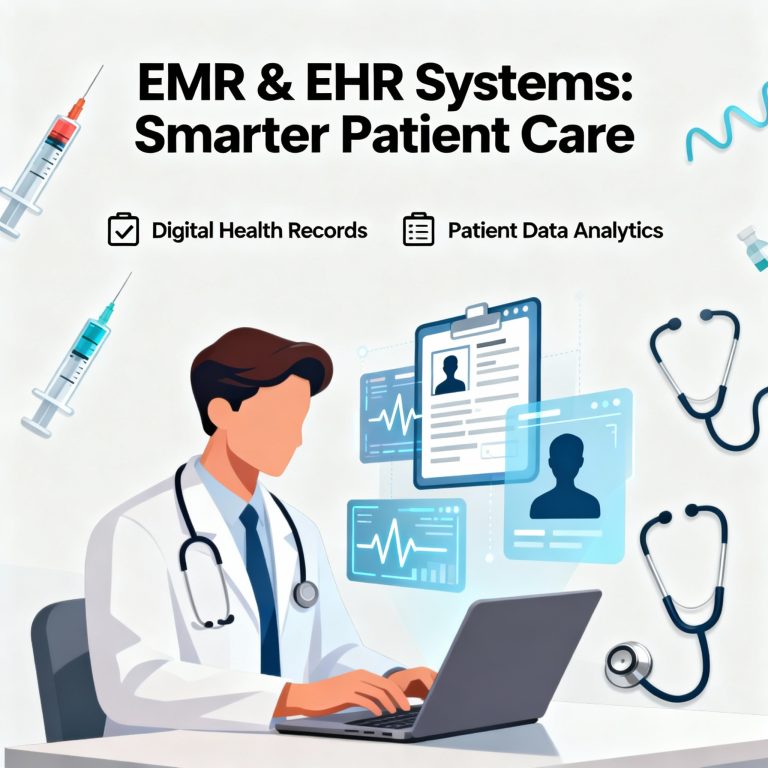In today’s fast-evolving digital era, healthcare systems are transforming faster than ever before. As medical institutions shift toward modernization, EMR software, EHR software, and electronic medical record systems are becoming the foundation of this revolution. These technologies not only enhance the efficiency of healthcare operations but also ensure smarter, faster, and more accurate patient care.
Moreover, as hospitals and clinics adopt digital solutions, the Electronic Medical Record Service is reshaping the way data is managed, shared, and utilized. From reducing paperwork to improving diagnostic accuracy, the integration of electronic medical records has created a more connected and responsive healthcare ecosystem.
Understanding EMR and EHR Software: The Backbone of Modern Healthcare
Before exploring their impact, it’s essential to understand the difference between EMR software and EHR software.
EMR (Electronic Medical Record) software is primarily designed for individual clinics or healthcare facilities. It allows medical professionals to store, access, and manage a patient’s medical history, diagnoses, medications, and treatment plans digitally. In contrast, EHR software extends this capability beyond one organization. It enables multiple healthcare providers to access and share a patient’s information securely, regardless of where the patient receives care.
Therefore, while EMRs focus on internal record management, EHRs promote interoperability and collaboration across healthcare systems. This difference, although subtle, plays a crucial role in improving overall healthcare delivery.
Furthermore, both EMR software and EHR software minimize human error, streamline documentation, and ensure that all patient data remains accessible and accurate at any time. Consequently, these digital solutions help medical professionals make better-informed decisions and deliver higher-quality care.
The Role of Electronic Medical Record Systems in Healthcare Efficiency
As healthcare facilities become increasingly data-driven, electronic medical record systems serve as an essential tool for improving efficiency and workflow. Traditionally, paper-based systems were cumbersome, error-prone, and time-consuming. However, with digital recordkeeping, the process of storing and retrieving patient information has become faster and more reliable.
Moreover, electronic medical record systems allow healthcare professionals to access real-time patient data with just a few clicks. This ease of access reduces duplication of tests, enhances communication between departments, and minimizes delays in treatment. Additionally, since the data is stored digitally, it can be analyzed to identify health trends, improve preventive care, and optimize resource allocation.
Furthermore, these systems support advanced functionalities such as automated reminders for follow-up appointments, prescription management, and digital billing. Therefore, both healthcare providers and patients benefit from smoother operations and more organized care management.
Electronic Medical Record Service: Connecting Healthcare Systems
One of the most remarkable advancements in the healthcare sector is the rise of Electronic Medical Record Service providers. These services make it easier for hospitals, clinics, and diagnostic centers to digitize their operations without building everything from scratch.
In addition, Electronic Medical Record Service providers offer cloud-based solutions that allow secure data storage and remote access. For example, doctors can now review a patient’s past medical history before a consultation, even if the patient visited a different hospital previously. As a result, patients no longer need to carry bulky files or repeat medical tests unnecessarily.
Moreover, such services promote seamless communication between different healthcare entities. For instance, a general practitioner can easily share a patient’s record with a specialist or laboratory, ensuring timely and coordinated treatment. This level of connectivity not only enhances operational efficiency but also significantly improves patient satisfaction and trust.

The Growing Importance of Electronic Medical Records in Modern Healthcare
The implementation of electronic medical records has brought about a major shift in healthcare management. Unlike traditional paper charts, digital records are easier to maintain, update, and retrieve. Furthermore, they eliminate the risks associated with misplaced or incomplete patient information.
In addition, electronic medical records provide a single, centralized database where every detail—from allergies and lab results to prescriptions and previous consultations—is securely stored. This helps doctors gain a complete understanding of a patient’s medical history and make better clinical decisions.
Moreover, with the help of analytics tools, hospitals can use electronic data to track health outcomes, measure treatment effectiveness, and forecast potential health risks. As a result, healthcare becomes more proactive and preventive rather than reactive.
Furthermore, electronic medical records also enhance patient engagement. Through patient portals, individuals can access their records, monitor their progress, and even book appointments online. This transparency empowers patients to take charge of their health while fostering stronger doctor-patient relationships.
How EMR and EHR Software Contribute to Smarter Patient Care
Both EMR software and EHR software are at the heart of smarter patient care. By digitizing every aspect of patient management, they enable healthcare providers to focus more on treatment rather than administrative tasks.
For instance, doctors can instantly review previous diagnoses, lab results, or prescriptions without flipping through piles of paper. This not only saves valuable time but also ensures more accurate treatment planning.
Moreover, EHR software enables multi-specialty coordination, which is especially important for patients with chronic or complex health conditions. Since data can be securely shared among different healthcare professionals, every member of a patient’s care team stays informed and aligned.
Additionally, automated alerts and reminders built into EMR/EHR systems help prevent medication errors, schedule regular follow-ups, and manage chronic disease care more effectively. Thus, these technologies directly contribute to improved patient safety and satisfaction.
Benefits of Adopting Electronic Medical Record Systems
The adoption of electronic health record systems comes with numerous benefits that extend beyond data management. Some of the key advantages include:
- Improved accuracy: Digital documentation reduces errors in patient information.
- Enhanced accessibility: Authorized users can access patient data anytime, anywhere.
- Faster workflows: Automated tasks save time and streamline healthcare processes.
- Better security: Data encryption and access control protect sensitive medical information.
- Informed decisions: Doctors can make data-driven choices with comprehensive health insights.
Furthermore, hospitals can integrate electronic medical record systems with telemedicine platforms, allowing patients to receive consultations online while their medical data remains securely available. This integration is especially beneficial in remote areas where access to healthcare facilities is limited.
Challenges and the Path Forward
Despite their advantages, the adoption of EMR software and EHR software still faces certain challenges. Some smaller healthcare centers find the initial cost of implementation high, while others struggle with staff training and system customization. Additionally, concerns about data privacy and cybersecurity remain significant.
However, with ongoing advancements in cloud technology and stronger data protection laws, these challenges are gradually being addressed. Moreover, governments and healthcare technology providers are actively promoting digital transformation in healthcare, making these solutions more accessible and affordable.
Therefore, as more healthcare organizations recognize the long-term value of digitalization, the shift toward comprehensive electronic medical records will only continue to accelerate.
Conclusion: Toward a Digitally Empowered EMR and EHR Software
In conclusion, EMR software, EHR software, electronic medical record systems, and Electronic Medical Record Service have become integral to modern healthcare. These technologies not only streamline operations but also ensure better coordination, improved patient outcomes, and smarter decision-making.
Moreover, as healthcare continues to evolve, the integration of electronic medical records will play a central role in shaping a future where technology and compassion work together seamlessly. By embracing these digital innovations, healthcare organizations can build a smarter, more connected, and patient-centered system that delivers excellence in every aspect of care.

